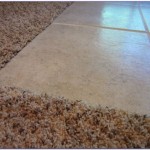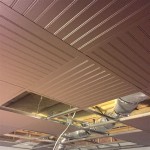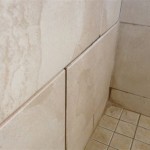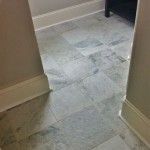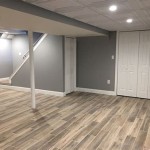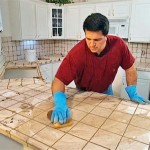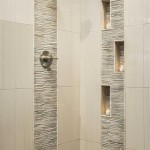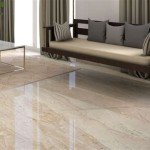Can You Put Flooring Over Ceramic Tile In Bathroom? A Comprehensive Guide
The question of whether new flooring can be installed over existing ceramic tile in a bathroom is a common one, especially for homeowners seeking to refresh their space with minimal disruption and cost. The answer, however, is not a simple yes or no. Several factors must be considered to ensure the success and longevity of such a project. This article delves into the various aspects of installing new flooring over existing ceramic tile in a bathroom, providing a comprehensive guide to help evaluate the feasibility and potential challenges of this approach.
The primary motivation behind installing new flooring over existing tile is often to avoid the labor-intensive and messy process of tile removal. Removing ceramic tile can be time-consuming, generate substantial dust and debris, and potentially damage the subfloor. Installing new flooring directly on top of the old tile can significantly reduce the project's timeline and minimize the disruption to the household. Furthermore, it eliminates the need for disposal of the old tile, potentially saving on landfill costs.
However, before proceeding with this approach, a thorough assessment of the existing conditions and the limitations associated with installing new flooring over ceramic tile is crucial. Ignoring these factors can lead to significant problems down the line, including compromised structural integrity, moisture issues, and aesthetic concerns.
Assessing the Existing Ceramic Tile
The first and most crucial step is to meticulously inspect the existing ceramic tile. The integrity and condition of the tile will directly impact the success of the new flooring installation. Several key aspects need to be evaluated:
Stability: Each tile must be firmly adhered to the subfloor. Loose, cracked, or missing tiles must be addressed before any new flooring is installed. Loose tiles can create uneven surfaces, leading to problems with the new floor covering. Attempting to install flooring over loose tiles will likely result in premature failure of the new floor, requiring costly repairs or replacements. Cracks in the existing tile can also indicate underlying issues with the subfloor, which need to be addressed independently.
Levelness: The existing tile surface must be relatively level. Significant variations in height between tiles or across the entire floor area can create challenges for the new flooring. Minor imperfections can often be addressed with self-leveling compounds, but major discrepancies might necessitate tile removal or extensive preparation. Uneven surfaces can cause warping or cracking in the new flooring, particularly if it is a rigid material like laminate or certain types of tile.
Grout Condition: Inspect the grout lines for cracks, deterioration, or missing sections. Damaged grout can indicate water penetration issues or underlying movement in the tile. Before installing new flooring, all grout lines should be thoroughly cleaned and repaired. Consider applying a grout sealant to prevent future moisture intrusion. Deteriorated grout can also create an uneven surface, mirroring the challenges caused by uneven tiles.
Moisture Issues: Bathrooms are inherently high-moisture environments, so it's essential to check for signs of water damage or mold growth around the existing tile. Leaks from plumbing fixtures, condensation, or inadequate ventilation can contribute to moisture problems. Addressing any existing moisture issues is paramount before installing new flooring. Water trapped beneath the new flooring can lead to mold growth, structural damage, and unpleasant odors.
Choosing the Right Flooring Material
Selecting the appropriate flooring material is critical when installing over existing ceramic tile. Not all flooring types are suitable for this application. Factors such as moisture resistance, thickness, and installation method should be taken into consideration.
Luxury Vinyl Tile (LVT) and Luxury Vinyl Plank (LVP): LVT and LVP are popular choices for bathrooms due to their excellent moisture resistance, durability, and relatively easy installation. They are available in various styles and finishes, mimicking the look of wood, stone, or tile. Many LVT and LVP products are designed with interlocking systems or can be glued down directly to the existing tile. When choosing LVT or LVP, ensure it is specifically rated for bathroom use and that the adhesive (if required) is compatible with ceramic tile.
Sheet Vinyl: Sheet vinyl offers a seamless, waterproof surface, making it an excellent option for bathrooms. It can be glued directly to the existing tile, providing a continuous barrier against moisture. However, installing sheet vinyl requires careful preparation and skilled installation to avoid bubbles or wrinkles. It is also essential to ensure the existing tile surface is smooth and free of imperfections that could telegraph through the vinyl.
Engineered Wood Flooring: While engineered wood is more moisture-resistant than solid hardwood, it is generally not recommended for bathrooms, especially when installed over existing tile. The potential for moisture penetration and the risk of warping or delamination are higher in a bathroom environment. If considering engineered wood, ensure it is specifically designed for high-moisture areas and that appropriate moisture barriers are installed.
Tile (Porcelain or Ceramic): While it may seem counterintuitive to install tile over tile, it is a viable option if the existing tile is in good condition and the overall floor height is not a concern. Thin-set mortar can be used to adhere the new tile to the existing tile surface. However, meticulous preparation is essential, including thoroughly cleaning the existing tile and applying a bonding agent to ensure proper adhesion. Additionally, the added weight of the new tile must be considered, ensuring the subfloor can support the increased load.
Laminate Flooring: Laminate flooring is generally not recommended for bathrooms due to its susceptibility to moisture damage. Even water-resistant laminate products can be compromised by prolonged exposure to humidity or spills. Installing laminate over existing tile in a bathroom can lead to swelling, warping, and mold growth under the flooring.
Preparing the Existing Tile Surface
Proper preparation of the existing tile surface is crucial for ensuring a successful and long-lasting flooring installation. This preparation involves several steps designed to create a clean, level, and bondable surface for the new flooring.
Cleaning: Thoroughly clean the existing tile surface to remove any dirt, grime, soap scum, or other contaminants. Use a strong detergent or degreaser specifically designed for tile and grout. Rinse the surface thoroughly with clean water and allow it to dry completely. Removing all contaminants ensures proper adhesion of the new flooring or the leveling compound.
Repairing: Address any cracks, chips, or loose tiles before proceeding. Replace loose tiles with new ones, using thin-set mortar to ensure a strong bond. Fill any cracks or chips with a tile repair compound. Allow the repair compound to dry and cure completely before sanding it smooth. Repairing these imperfections creates a more level and stable surface for the new flooring.
Leveling: If the existing tile surface is uneven, use a self-leveling compound to create a smooth and level base for the new flooring. Follow the manufacturer's instructions carefully when mixing and applying the leveling compound. Ensure the compound is compatible with ceramic tile and the chosen flooring material. Self-leveling compounds can effectively eliminate minor imperfections and create a consistent surface for installation.
Sanding or Scarifying: Lightly sanding or scarifying the existing tile surface can improve the adhesion of the new flooring or leveling compound. This process creates a slightly rougher surface, providing a better mechanical bond. Use a fine-grit sandpaper or a scarifying tool designed for tile. Be careful not to damage the existing tile during this process. Dust thoroughly after sanding or scarifying.
Priming: Apply a primer specifically designed for bonding to ceramic tile. This primer will further enhance the adhesion of the new flooring or leveling compound. Choose a primer that is compatible with both the existing tile and the chosen flooring material. Allow the primer to dry completely before proceeding with the installation.
Beyond the foundational steps, considerations must be given to the overall height increase. Adding a layer of flooring over existing tile will raise the floor level. This can impact door clearances, transitions to adjacent rooms, and the height of plumbing fixtures such as toilets. Doors may need to be trimmed, transitions installed to create a smooth change in floor height, and the toilet flange may need to be extended to ensure a proper seal.
Finally, it's important to consult local building codes and regulations before commencing any flooring project. Some codes may have specific requirements regarding floor heights, moisture barriers, or the types of flooring materials permitted in bathrooms. Consulting with a qualified contractor or building inspector can help ensure compliance with all applicable regulations.

How To Lay Vinyl Flooring Sheet Over Tiles

What Type Of Flooring Can You Install Over Ceramic Tile

What Type Of Flooring Can You Put Over Ceramic Tile Tidy Floor Jahidul Alam

What Type Of Flooring Can You Put Over Ceramic Tile

Tiling Over Tiles Is It A Good Idea How You Can Do Right

What Type Of Flooring Can You Install Over Ceramic Tile

What Type Of Flooring Can You Put Over Ceramic Tile Rubi Blog Usa

New Vinyl Plank Flooring Over Tile Table And Hearth

Lvt Flooring Over Existing Tile The Easy Way Vinyl Floor Installation Diy Gulv

Best Bathroom Flooring Options
Related Posts

